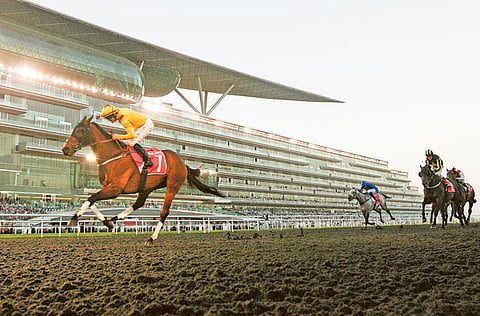Meydan Racecourse bids Tapeta track goodbye
Controversial all-weather surface set to be replaced by vintage dirt track

Dubai: In a major development, which will potentially impact the world of horse racing, Meydan racing officials announced on Wednesday that the Tapeta all-weather surface at Dubai’s Meydan Racecourse will be replaced by a dirt track.
The decision comes just five years after the artificial race track, which was developed by steeple-chasing Hall Of Famer Michael Dickinson, made a much-publicised debut at the iconic racecourse, which is home to the $10-million (Dh36.72 million) Dubai World Cup (G1), the world’s richest horse race.
However, since then the surface has had to endure some of the harshest criticism, most recently by Shaikh Hamdan Bin Rashid Al Maktoum, Deputy Ruler of Dubai and Minister of Finance, who is one of the world’s most influential owners and breeders.
Explaining the strategic development, Saeed Al Tayer, Chairman and CEO of Meydan Group, said in a press release: “This is a decision that will be best for the future of Meydan racing and the Dubai World Cup Carnival.
“In the coming year, we will celebrate the 20th running of the Dubai World Cup and the track will be the natural surface that proved so successful during the first 14 years of this magnificent race day.”
The Dubai World Cup was conceptualised as the definitive world championship by His Highness Shaikh Mohammad Bin Rashid Al Maktoum, Vice-President and Prime Minister of the UAE and Ruler of Dubai, and the inaugural running in 1996 was won in sensational style by American superstar Cigar.
It continued to produce some outstanding races with top class winners like Dubai Millennium, Captain Steve, Roses In May and Curlin during its 14-year tenure at Nad Al Sheba, before being shifted to the Tapeta all-weather track in 2010 where Japan’s Victoire Pisa triumphed.
However, with the demise of artificial race surfaces gaining ground in North America, where bastions like Keeneland and Del Mar have abandoned their all-weather tracks and reverted to traditional dirt, the depth and quality of recent renewal of the Dubai World Cup have come into question.
The switch to Tapeta has also seen a significant drop in the number of American-trained horses competing at the Dubai World Cup Carnival while this year’s event did not attract a single World Cup contender for the first time in the race’s 19-year history.
The five winners of the race on the all-weather have been trained in France, Japan, UAE and America.
Synthetic track surfaces are generally used for training purposes in Europe although they have their uses at some racecourses which experience extreme weather conditions.
Earlier this year, just days prior to the Dubai World Cup, Shaikh Hamdan told Gulf News that the Tapeta surface “was a good track in the first year, but has changed in recent years.”
“If you ask me, the race is not as strong as it used to be and that’s because the Americans are not here. They prefer the old track,” Shaikh Hamdan said.
“Not all horses give their best on the surface where the ground conditions change every few metres. New horses to the surface shorten their strides and don’t stretch naturally. It is also inconsistent: It’s slow in the morning and fast in the evening.”
All racecourse managements around the world are also placing emphasis on factors that can reduce the risk of injury to the race horse, with the track surface being of paramount importance.
Gulf News has learnt that a dirt surface similar to the one at Nad Al Sheba racecourse will be installed at Meydan.
Sign up for the Daily Briefing
Get the latest news and updates straight to your inbox